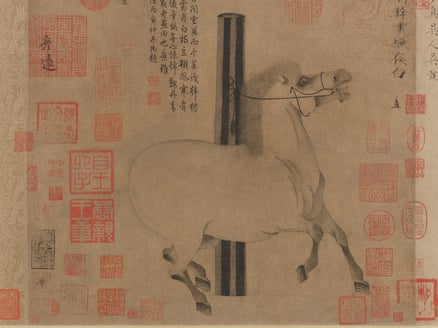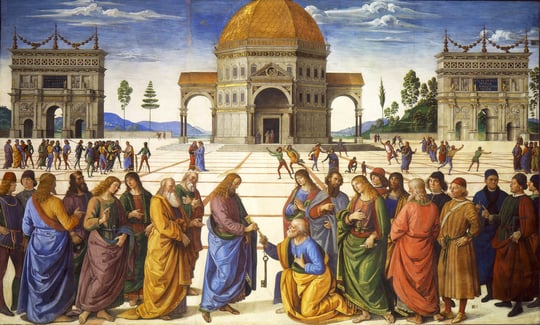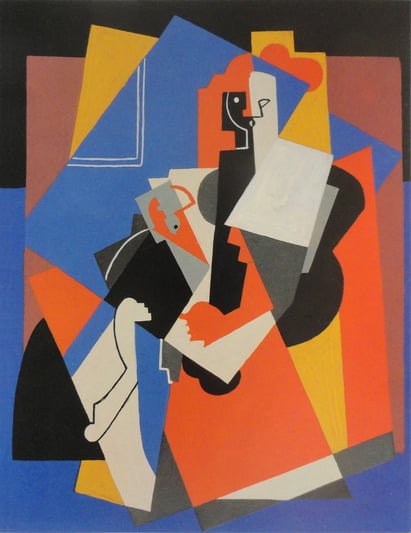Many of us, when we look at a picture, expect what amounts to a “window” into reality—figures inhabiting a discernibly three-dimensional space with a foreground, background, and expanse in between. Even though our visual environment today is richly diverse, and many other kinds of “pictures” exist (modernist, abstract pictures, for example), most of us still think of pictures as stages of action with recognizable settings and figures dispersed near and far within those bounds.
But it hasn’t always been that way.
Renaissance Art and Three-Dimensional Space
In a landmark essay called "On Some Problems in the Semiotics of Visual Art: Field and Vehicle in Image-Signs," influential art historian Meyer Schapiro demonstrated how many of the world’s artists have not conceived of painted figures as inhabiting their own, separate, pictorial space—their own painted “world.” Instead, for a long time, most “pictures” were figures on neutral grounds. In this older paradigm, the “heroes of the story” were less like bodies in space, and more like elaborate letters written on a flat surface: they were special kinds of hieroglyphs. Consider, for example, a famous picture from Tang Dynasty China depicting the legendary warhorse Night Shining White. This redoubtable, muscular beast is depicted in ink against a white paper background with no real ground line, no architecture, no foliage, and no sky. There is only a hitching post to serve as a centering line. Around the horse, sharing its space, are letters and stamps of ownership. All, in a way, are glyphs of greater or lesser complexity, arrayed on parchment to be “read.”
 Night-Shining White by Han Gan from the Metropolitan Museum of Art / CC0 via Wikimedia Commons
Night-Shining White by Han Gan from the Metropolitan Museum of Art / CC0 via Wikimedia Commons
In a departure from this ancient trend, Italian artists during the Renaissance seem to have invented the deep, mathematical, box-like three-dimensional perspective that still informs much picture-making today. Ancient Greek and Roman artists attempted effects of deep space in some of their pictorial works, but these ancients seem not to have hit upon the convincing solution developed by Renaissance-era artists like Leon Battista Alberti, Andrea Mantegna, and Pietro Perugino. Why is it that European artists in the period we call the Renaissance evolved such a distinctive and persuasive approach to three-dimensional space?
Renaissance Art and the Viewer
The great German art historian Irwin Panofsky has linked the invention of three-dimensional, linear perspective in the Renaissance to ideological shifts that prioritized the solitary individual. Panofsky observed that the slanting perspective lines of three-dimensional Renaissance space converge on a single point in the “background” of an image and then extend radially and symmetrically to visually “embrace” a viewer centered before the picture. This arrangement could seem to position the viewer as a godlike eye surveying a self-contained, totally comprehensible “universe.” Once positioned right before a Renaissance picture, in just the right spot, the Renaissance viewer could feel like the center of everything as if everything was under his (or her) control. Renaissance space was a domain of mastery, even if the mastery was fictional. It was, therefore, highly gratifying to the individualistic, competitive, investigating Renaissance mind.
Panofsky was not alone in this intuition. Many of the abstract art movements of the early twentieth century explicitly charged the Renaissance perspective with a certain kind of individualistic egotism. For example, some of the first Cubists criticized and tried to replace the realistic perspective of classic Euro-American painting with something they found more ethical and truthful. The Cubist Manifesto of 1912, in fact, plainly declared the Renaissance perspective to be “egocentric,” and argued that the Cubists’ own fractured, dispersed approach to figures in space was at once humbler, more genuinely spiritual, less culturally specific, and more respectful of the porous, fluid, interconnected reality of modernity. The Cubists’ ideas are still reflected today in the flat, sleek, abstract geometric style that characterizes our modern cities, our media/advertising environment, and even much fashion and interior design.
Woman and child, on the cover of Der Sturm, by Albert Gleizes (one of the authors of the Cubist Manifesto), 5 October 1921 / Public domain in the United States via Wikipedia.org
The Sacred Art of Pietro Perugino
Back in the heady days of the fifteenth-century Renaissance, the Italian Pietro Perugino was one of the first artists to use the era’s three-dimensional perspective techniques to their full effect. Perugino was also an important figure in Catholic Church history. Not only was he the teacher of the famous Raphael, who eventually decorated the Papal apartments and helped design St. Peter’s basilica, but he also contributed to the design of the Sistine Chapel. Perugino’s frescoes still adorn the walls of the chapel, just beneath the famous ceiling by Michelangelo. In fact, Perugino’s fresco Christ Giving the Keys to St. Peter is one of the most iconic images in the chapel, and it is also a major expression of “visual theology,” showing the institution of the papacy and its implications for society.
 Delivery of the Keys by Pietro Perugino / Public domain, via Wikimedia Commons
Delivery of the Keys by Pietro Perugino / Public domain, via Wikimedia Commons
But was Perugino “egocentric?” Or at least, did he encourage egocentrism by perfectly containing a biblical scene in a deep, little perspectival box?
I don’t think so.
First, as visitors to the Sistine Chapel can attest, Peugino’s Christ Giving the Keys (just like all the other wall frescoes) is not at human eye level. In fact, the “ideal” viewer for Perugino’s image would be a hovering angel! In some ways, Christ Giving the Keys was made primarily for God’s eyes.
Second, I think Perugino’s deep, detailed rendering of space, extending into a far background and embracing a wide variety of people engaged in manifold little activities, is based on reverence and respect, not a will to dominate.
In their “conquest” of three-dimensional space, Perugino and his contemporaries wanted to register every single part of historical and biblical events—not just the “main characters.” They didn’t want to collapse and squeeze out the spaces between and behind things, because that space itself carried meaning. In other words, Perugino and his peers wanted to show that Jesus came into space and time, traversing ground with feet that were God’s feet, perceiving light with eyes that were God’s eyes, and greeting friends, near and far, with distant calls from the very lungs of God! Jesus’s incarnation showed that three-dimensional space—dirt, air, trees, water, sky—was sacred. It shouldn’t be “left out.” Just as pilgrims to the Holy Land venerated the ground where Jesus walked, so artists like Perugino venerated—and strove to evoke—the space Jesus and His disciples inhabited. Space, expanse, air, light, distance—none of these things were extraneous in God’s self-revelation. And when Jesus dwelt amidst these things, He activated them in a new way, making them part of the grand Second Act (that is, the New Covenant) in salvation history.
All Space and Time Are Sacred
We can see, then, that the Renaissance space of Perugino and his colleagues is a precious, noble stage within which God himself acted, extending His quickening grace and love all around, to every part of Creation. The work of artists like Perugino is an excavation and expansion of something that had before been only dimly seen. It extended meaningfulness not only to “major actors” floating like hieroglyphs on neutral grounds but to everything else—all space and time—that surrounded the “major actors” and accompanied them. This impulse generously extended the spirit of St. Francis of Assisi’s nature canticles (praising “brother sun” and “sister moon”) to literally everything. (St. Francis would have approved!). When artists like the Cubists tried to collapse this space again, supposedly in the interest of humility, they, in some ways, denied its dignity. They had begun to turn toward a more esoteric, gnostic understanding of the world that no longer saw matter as the precious design of God.
There are beauties in Cubism, just as there are beauties in all great art movements. But it is important to recognize the inspirations of our forebears. It is never good to assume that “newer” is automatically “better.” In our age of ubiquitous media availability, when we have past and distant cultural manifestations at our fingertips, we have the unprecedented opportunity to compare and discern cultural ways of visioning reality. Which approaches (once we understand them) best represent the truth? Which approaches most nourish and delight our souls?



